Powerful hardware, large high-res screen and the latest Android version in a solid metal body– the recipe did wonders for the original Desire so no wonder HTC are in no mood to experiment with the sequel. Take the best and make it better pretty much sums up the game plan. Oh well, we’ll take quietly brilliant even if emphasis is sometimes on quiet. In other words, the Desire S is a phone we’re ready to like. But make no mistake – it’s not meant to be the flagship its predecessor was. HTC has the Sensation to send against the heavyweight competition. The new Desire is given a different, though no less important role. Ideally, it should be the smartphone that has broader appeal, the one to offer as reward to loyal upgraders. The phone to give you – wait for it – more bang for your buck than we’ve come expect from HTC. Here’s what it puts on the table summarized. Those coming from the original Desire will certainly notice the absence of the optical trackpad and that now capacitive keys replace the hardware buttons. It’s a different way of interacting with the phone but by no means less comfortable. Other than that, the new smartphone certainly does well to upgrade the original. You get more RAM, a slightly more compact and lighter body, which is still solid enough thanks to all the metal, along with the latest Android and a more powerful GPU. Video-chat enthusiasts will cheer the front-facing camera, while those who want lots of apps installed on their smartphones will appreciate the extended built-in memory. The bad news is the Desire S is – in more than one way – running against the clock. A year is a really long time in cell phone terms and there’s no guarantee the updates are enough to make it competitive in a market that’s embracing dual-core and pushing beyond the 1GHz mark.Key features
Main disadvantages
This post is sponsored by:
Dr Mobiles Limited
1 Huron Street, Takapuna, North Shore 0622
Tel: (09) 551-5344 and Mob: (021) 264-0000
Web - Map - Email - Posterous - Twitter - Blogger - Flickr![]()
![]()
![]()
Friday, June 3, 2011
Google Android Phone Review 2011: HTC Desire S (www.drmobiles.co.nz) +64212640000
Cell Phone Review 2011: Motorola Atrix 4G review (www.drmobiles.co.nz)
It was the alliance with Android that put Motorola out of the woods. Like every partnership, it’s been a series of peaks and dips but every now and then the relationship between Motorola and Android goes beyond a mere marriage of convenience and well into a simmering love affair. They did it with the MILESTONEs and the DROID X, the BACKFLIP and the DEFY. With the ATRIX 4G, Moto says it has no plans to live in the shadows of other big makers. The Motorola ATRIX 4G is the first dual-core smartphone in the Motorola line-up. It’s also the first to flaunt a qHD touchscreen. That’s as solid as credentials get. Add the fact it’s the first handset for Motorola to support the fast HSDPA+ network (hence the 4G moniker) and you’ve got yourself a Droid that’s not afraid of what comes next. Dual core is certainly the next big thing in mobile phones and the Motorola ATRIX deserves credit for being among the first – our bad really, this review isn’t exactly on time. But there are other bold decisions that Motorola had to make. The HD and laptop docks for one – though the concept is not exactly original, Motorola is trying to make it mainstream. The added fingerprint scanner is not new either but well forgotten old does just as well. Plus, it will satisfy the privacy freak in all of us. Anyway, the standard package is what we’re interested in and this is what our review will focus on. The optional extras can wait. The ATRIX is more important to us a phone (a dual-core smartphone, to be precise) than a wannabe laptop or a potential entertainment dock. Let’s waste no more time and take a glimpse of the ATRIX 4G’s key features. The ATRIX 4G is certainly the most powerful phone Motorola has made so far. With a 1GHz dual-core processor, 1GB worth of RAM and the ultra low power GeForce GPU under its hood, the ATRIX 4G is set to win the hearts and minds of power users. Garnish all this premium hardware with a 5MP camera with dual LED flash and a 4-inch capacitive touchscreen of qHD resolution of 540x960 pixels, and the ATRIX 4G is more than ready to play with the other dual-core kids.


Motorola ATRIX 4G official photosKey features
Main disadvantages
This post is sponsored by:
Dr Mobiles Limited
1 Huron Street, Takapuna, North Shore 0622
Tel: (09) 551-5344 and Mob: (021) 264-0000
Web - Map - Email - Posterous - Twitter - Blogger - Flickr![]()
![]()
![]()
Google Trend: Mobile phone usage report 2011 (www.drmobiles.co.nz)
Did you ever wonder what kind of phone usage is normal? We seem to have a pretty good idea. Are cell phones still mostly used for making calls or has web browsing already taken over? The answer is right here. In some places, more people use their phone as a wakeup alarm than they do to make calls. More people use music recognition in North America than in any other place on Earth. You told us what features are used daily and what are only needed once in a while. We also know which are the most wanted but, for various reasons, still not widely used. Before we go on though, we’d like to thank you for taking part in our survey so actively. More than 15,000 people responded, 10,000 of which clocked in the first 24 hours alone. As you could imagine, the results should be representative enough given the number of respondents representing various age groups, both genders and different continents. And while the results can most probably apply to mobile phone enthusiasts all over the world they are hardly accurate as far as the whole world population is concerned. The thing is you, our faithful audience, are not exactly the average phone users. Being so informed and passionate about cell phones (why would you else be here reading all those long reviews) you tend to spend more time with your phone and use most of the features. Here are some numbers that prove this further: 96% of all respondents browse the web on their mobile phone and more than 88% have a Wi-Fi enabled handset. You won’t be able to bring those numbers to the next class reunion, but you might just learn what your fellow commenters do on their handsets. One final note before we begin: about 30% of the voters chose not to provide personal information but we still have plenty of feedback to be able to tell how the results vary across the different gender/age/location groups.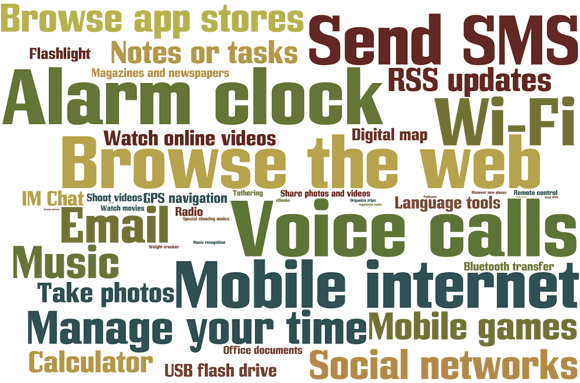

Most used daily
We start with the most important features, i.e. the ones that are used most frequently by most users. And the winner here… couldn’t have been more obvious… is voice calls.
What came as a slight surprise however is the actual percentage – we expected results more in 95%+ range, so much so that we even considered leaving it out of the poll. Glad we didn’t, because we now see that not everyone use their phone as a phone. And in some user groups, the voice calls are even less popular – less than 65% of the teenagers talk daily on their phones.
In fact, voice calls only rank sixth in popularity in that group and it also loses its top spot among users aged 18 to 24 (though the feature retains a respectable 83% of daily usage there).
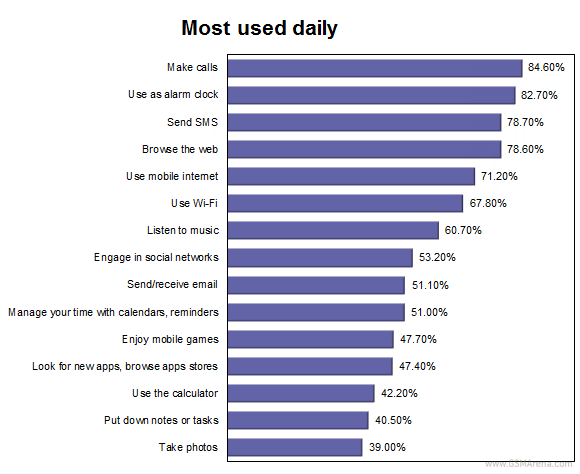
In terms of location, voice calls are most popular in Africa (89.5%) and least popular in Oceania (5th place at 77.6%).
The second most used feature worldwide was a bit of a surprise to us – with 83% it is alarm clock that snatches the silver. The feature even tops the chart for several user groups – women (81.3%), ages 18-24 years (83.5%) and South Americans (86.5%). It loses some ground with the users older than 41, but its popularity is consistently above 60%.
Sending texts might be in decline, but it still retains third position in daily usage. Its overall share is 78.7% and it even gets the number one place in Oceania with 87.7%.
SMS is also enjoying higher than average popularity with Asians (83.8%), where it’s just a tenth of a percent behind alarm clock usage. Surprisingly, only 75.8% of teenagers send SMS daily, which is less than average. Which is not to say that teenagers are no longer responsible for most of the SMS traffic. One possible answer here is that some teens are already switching to instant messaging – our data shows that one third of them are already using this feature daily.
Web browsing only loses a place on the podium by a whisker, which actually tells us how popular handheld browsing is (a mobile version of our site is in the works). 78.6% of the users open their mobile browsers daily. The champions in mobile web browsing category are Oceania (83.3%) and North America (80.9%) with browsing the second most used feature there.
This feature is less often used by women (70%) and users over 50 (63%).
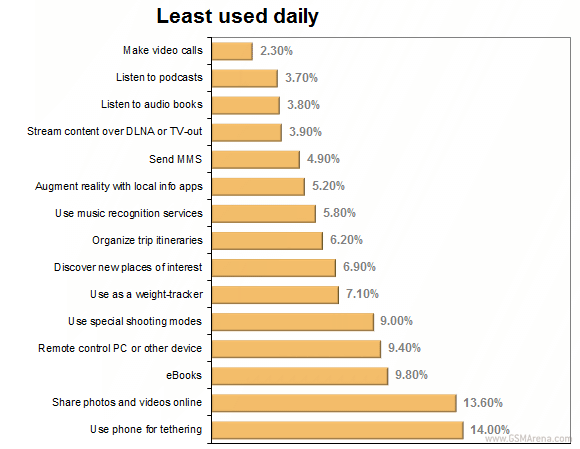
Essential features
The chart we’re about to look at shows the features that are used by the largest number of people. Although not necessarily needed daily, they are the most likely must-haves for users shopping for their next handset.
The obvious leader again is voice calls: 99.5% of you make calls at least ones every few weeks. In Oceania the feature which gave cell phones a reason to exist scores a perfect 100%, while the US gets pretty close with 99.9%.
In terms of overall use, SMS moves up to second place with 99.2%. And it’s another perfect score here from Oceania.
Taking photos is every bit as important as we expected – it grabs the third spot here with 98.5%. It means that less than one in 66 users never use the camera at the back of their cell phone. And half of those have answered that they would use that feature if they could, which suggests that their handsets don’t have a (decent) camera at all.
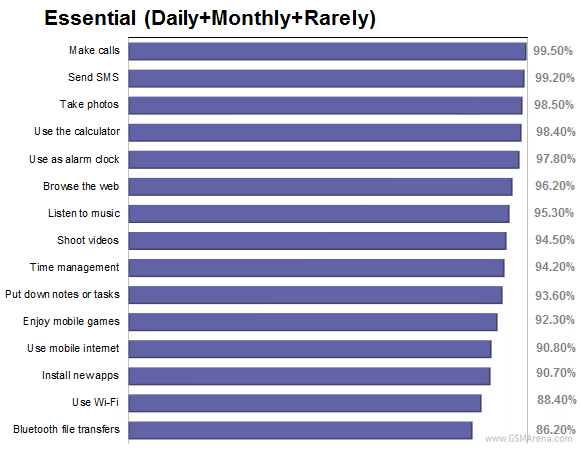
The two features that only just failed to make in to the medals are calculator (98.4%) and alarm clock (97.8%), while web browsing to sixth with the very respectable 96.2%.
At the other end of the spectrum is video calling, which is only used by 26.6% of all users. Only 2.3% of you make video-calls on a daily basis.
Audio books (33.5% total and 3.8% daily) and podcasts (33.8% and 3.7% daily) are not too popular either but they are still head and neck above video-calls. Streaming content over DLNA or TV-out only just avoided relegation with 34.1% users doing it at all and only 3.9% needing it daily.
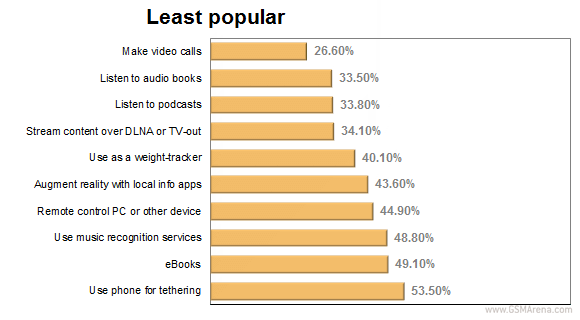
This post is sponsored by:
Dr Mobiles Limited
1 Huron Street, Takapuna, North Shore 0622
Tel: (09) 551-5344 and Mob: (021) 264-0000
Web - Map - Email - Posterous - Twitter - Blogger - Flickr
2011 Tech News Update: Sony Ericsson XPERIA Neo Review (www.drmobiles.co.nz)
It’s a sequel. Same cast and the same story but with a new lead and a new director. Shot in HD. The Sony Ericsson XPERIA Neo is to settle some unfinished business at the box office. A year stands between the Vivaz and the Neo and Android does make all the difference.



Sony Ericsson XPERIA Neo official photos
The XPERIA Neo is part of Sony Ericsson’s new droid lineup and takes advantage of all the new features – the LED-backlit Reality display with Sony Mobile BRAVIA Engine, an 8 megapixel Exmor R camera sensor, 720p video with continuous autofocus and the latest Android – 2.3 Gingerbread.
Key features
- Quad-band GSM /GPRS/EDGE support
- 3G with 7.2 Mbps HSDPA and 5.76 Mbps HSUPA
- 3.7" 16M-color capacitive LED-backlit LCD touchscreen of FWVGA resolution (480 x 854 pixels) on Sony Mobile BRAVIA engine
- Android OS v2.3 Gingerbread
- 1 GHz Scorpion CPU, Adreno 205 GPU, Qualcomm Snapdragon MSM8255 chipset
- 512 MB RAM
- 8 MP autofocus camera, LED flash, geotagging
- 720p video @ 30fps, continuous autofocus
- Front facing VGA camera, video calls
- Wi-Fi b/g/n and DLNA
- GPS with A-GPS
- microSD slot (32GB supported, 8GB card included)
- Accelerometer and proximity sensor
- Standard 3.5 mm audio jack
- Stereo FM radio with RDS
- microUSB port (charging) and stereo Bluetooth v2.1
- Voice dialing
- Adobe Flash 10.2 support
- microHDMI port
Main disadvantages
- Display has poor viewing angles
- The competition has dual-core CPUs, 1080p video
- No smart dialing
- Loudspeaker has below average performance
- No DivX/XviD support
- Memory card slot under the battery cover
The Neo benefits from new technology but it does well to focus on the important stuff: imaging. It’s not the 3.7 touchscreen that makes this phone, nor is it the 1 GHz CPU or the latest Android Gingerbread. And hey, these are all fine features to have. But in the Sony Ericsson XPERIA Neo the HD-enabled cameraphone comes before the all-round droid smartphone.



Sony Ericsson XPERIA Neo at ours
The short list of downsides gives away a well-focused device. The XPERIA Neo is spared the predicament of a flagship too. While the Arc might be unsettled by the new dual-core beasts – the Neo doesn’t need top specs to be good at its main job. The previous generation hardware is less of a disadvantage.
Having met the Neo, this review doesn’t look as such a tough challenge. All it needs to do is cement the good impression it already made. Such kind of safety can be deceptive though. Let’s hope the Neo didn’t let its muscles soften.
This post is sponsored by:Dr Mobiles Limited
1 Huron Street, Takapuna, North Shore 0622
Tel: (09) 551-5344 and Mob: (021) 264-0000
Web - Map - Email - Posterous - Twitter - Blogger - Flickr
Untitled
The HTC ChaCha is now available for purchase through the Phones 4U dealer in the UK. The Facebook-centric messenger can be yours for free on a two year 20 quid a month Vodafone contract or a whopping 300 pounds if you'd prefer to go pay-as-you-go. Update: It seems that Carphone Wearhouse is also listing the HTC ChaCha as available in the UK. Prices are similar to those of Phones 4U, save for the sim-free price of 230 pounds. The controversial ChaCha is a 2.6-inch HVGA (320x480) full-QWERTY messenger phone with a dedicated Facebook button and Gingerbread 2.4 on board. The HTC Sense on it is also socially integrated to make your day-to-day life more involved with your online peers.
This post is sponsored by:Dr Mobiles Limited
1 Huron Street, Takapuna, North Shore 0622
Tel: (09) 551-5344 and Mob: (021) 264-0000
Web - Map - Email - Posterous - Twitter - Blogger - Flickr![]()
![]()
![]()










